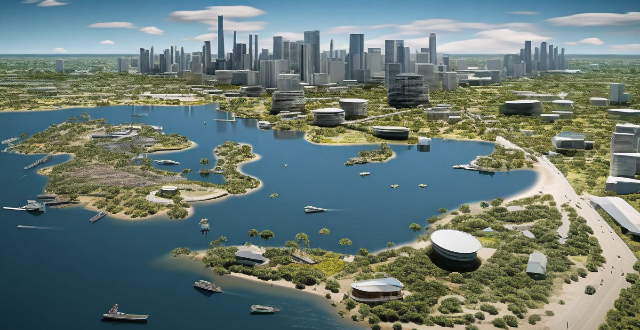Urban heat islands, areas within cities that are significantly warmer than surrounding rural areas, have a significant impact on city planning and design. This phenomenon is primarily due to the concentration of buildings, pavements, and other infrastructure that absorb and retain heat. The impact of urban heat islands extends beyond just temperature differences, influencing various aspects of city planning and design. These include increased energy consumption, public health concerns, water management, green spaces and landscaping, transportation planning, building materials and construction techniques, community design and zoning, climate change adaptation, and public awareness and education. Addressing these challenges requires a multifaceted approach that considers energy efficiency, public health, water management, green spaces, transportation, building materials, community design, climate change adaptation, and public awareness. By taking these factors into account, cities can become more livable, sustainable, and resilient in the face of rising temperatures.

Urban Heat Islands: Impact on City Planning and Design
Urban heat islands are areas within cities that are significantly warmer than surrounding rural areas. This phenomenon is primarily due to the concentration of buildings, pavements, and other infrastructure that absorb and retain heat. The impact of urban heat islands extends beyond just temperature differences, influencing various aspects of city planning and design. Here's how:
Increased Energy Consumption
- Air Conditioning Demand: Higher temperatures lead to increased demand for air conditioning, which consumes more energy. This can strain the city's power grid and increase utility costs for residents and businesses.
- Building Design: To combat the heat, architects and engineers may need to incorporate more advanced cooling systems into building designs, which can increase construction costs.
Public Health Concerns
- Heat-Related Illnesses: Higher temperatures can lead to heat stroke, dehydration, and other heat-related illnesses, especially among vulnerable populations like the elderly and children.
- Air Quality: Heat can exacerbate air pollution issues, as warm air can trap pollutants closer to the ground, affecting respiratory health.
Water Management
- Evaporation Rates: Higher temperatures can increase evaporation rates in water bodies and landscapes, requiring more water for irrigation and maintenance.
- Stormwater Runoff: Extreme temperatures can lead to more frequent and intense storms, necessitating better stormwater management systems to prevent flooding.
Green Spaces and Landscaping
- Urban Heat Island Effect Mitigation: Incorporating more green spaces and trees can help mitigate the urban heat island effect by providing shade and evaporative cooling.
- Sustainable Landscaping Practices: Using native plants that require less water and are adapted to local climates can reduce the need for irrigation.
Transportation Planning
- Pedestrian Comfort: High temperatures can make walking or cycling uncomfortable, discouraging these modes of transportation.
- Reflective Surfaces: Incorporating reflective materials in roads and sidewalks can help reflect sunlight and reduce heat absorption.
Building Materials and Construction Techniques
- Thermal Mass and Insulation: Using materials with high thermal mass and effective insulation can help regulate indoor temperatures without relying heavily on mechanical cooling systems.
- Green Roofs and Walls: Installing vegetation on roofs and walls can provide insulation, absorb rainwater, and contribute to cooling through evapotranspiration.
Community Design and Zoning
- Compact Development: Dense, compact development can reduce the amount of impervious surfaces, leading to less heat absorption.
- Shade Provision: Ensuring adequate tree cover and shading structures in public areas can improve outdoor comfort levels.
Climate Change Adaptation
- Resilient Infrastructure: As global temperatures continue to rise, designing infrastructure that can adapt to changing conditions becomes crucial.
- Emergency Response Planning: Having plans in place for heat waves and other extreme weather events is essential for protecting public health.
Public Awareness and Education
- Heat Island Awareness Campaigns: Educating the public about the urban heat island effect and how individuals can contribute to its mitigation can foster a culture of sustainability.
- Community Gardens and Greening Initiatives: Encouraging community involvement in greening initiatives not only helps combat the heat island effect but also builds social cohesion.
In conclusion, urban heat islands pose significant challenges for city planners and designers. Addressing these challenges requires a multifaceted approach that considers energy efficiency, public health, water management, green spaces, transportation, building materials, community design, climate change adaptation, and public awareness. By taking these factors into account, cities can become more livable, sustainable, and resilient in the face of rising temperatures.